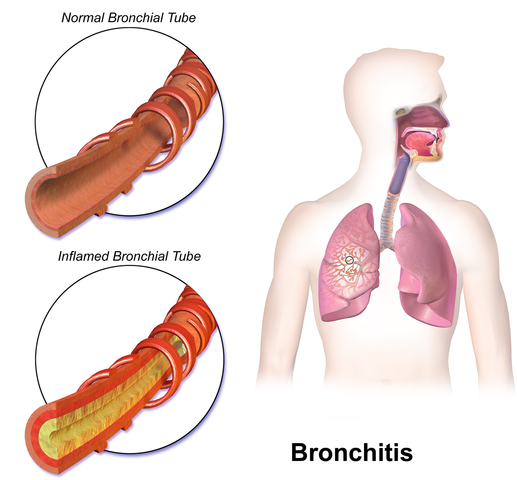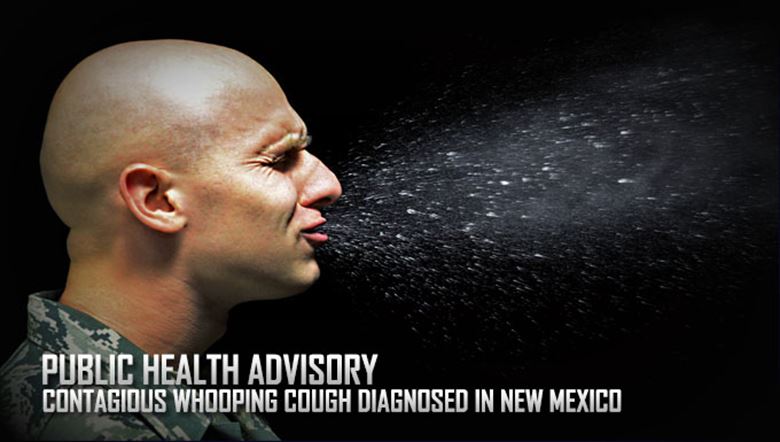Difference Between Bronchitis and Whooping Cough
What is Bronchitis and Whooping Cough?
Both Bronchitis and Pertussis (Whooping cough) are respiratory problems with similar symptoms. However, the two differ in terms of their diagnosis and causes. Their treatment also differs. Bronchitis is usually caused by different viruses or bacteria and Pertussis or whooping cough is a respiratory infection that is caused by Bordetella pertussis bacterium.

What is Bronchitis?
Bronchitis is the swelling of the bronchial tubes (large and medium-sized air passages) in the lungs. Symptoms include wheezing, chest pain, sleeping difficulty, coughing up thickened mucus and shortness of breath.
- Acute bronchitis: This type of bronchitis is a common one. Symptoms last for a few days or few weeks. The inflammation is due to viral or bacterial infection. The coughing lasts less than 10 days and once treated, symptoms don’t come back.
- Chronic bronchitis: This type is more serious. The coughing lasts for several weeks and the symptoms keep coming back or do not go away at all. It also causes a serious condition known as chronic obstructive pulmonary disease (COPD).
The condition is self-treatable and includes soothing remedies to help with chest discomfort and coughing, that may last weeks. Antibiotics are not usually recommended.
What is Whooping Cough?
Whooping cough is also known as pertussis and is a contagious infection. The infection causes coughing (cough that sounds like “whoop”), choking, runny nose, fever, and difficulty breathing. It is a bacterial infection of the respiratory tract. The infection spreads easily by coughing, sneezing, shared drinks and skin – to – skin contact i.e. handshakes. Complications due to prolonged coughing include pneumonia and seizures. The best possible treatment for Pertussis is vaccination. It also minimizes the number of people in the community who can spread the bacteria.
The 3 stages of Pertussis include
- Catarrhal (runny nose) stage
- Paroxysmal stage
- Convalescent stage

Difference Between Bronchitis and Whooping Cough
Definition
Bronchitis
Bronchitis is defined as an irritation and swelling or inflammation of the lining of the bronchial tubes (bronchi). These tubes swell and accumulate mucus causing difficulty to breathe. There are two types – acute bronchitis and chronic bronchitis.
Whooping Cough
It is commonly known as Pertussis and is a bacterial infection of the respiratory tract. It is caused by bacteria known as Bordetella pertussis.
Causes
Bronchitis
Viruses are responsible for causing acute bronchitis in 85% to 95% of adults who otherwise do not have any health issues, and bacteria are responsible for the remaining cases.
Whooping Cough
Whooping cough is bacterial infection and is also termed as Pertussis. It is highly contagious and is caused by bacteria called Bordetella pertussis. These bacteria cling to the cilia (small and thin hair-like extensions) along the upper respiratory system and secrete toxins which harm the cilia and lead to swelling in the airways. It can easily spread from person to person.
Diagnosis
Bronchitis
- Chest X-Ray
- Sputum test – Testing of sample of mucus you cough off (Sputum)
- Spirometry – Test of lung function
Whooping Cough
- A nose or throat culture and test – Swab or suction sample to check for evidence of the presence of Pertussis bacteria.
- Blood test – Test to check WBC as high WBC count typically indicates the presence of inflammation or infection
- Chest X-ray – Presence of inflammation of lungs
- Polymerase Chain Reaction (PCR)
- Antibody detection
Symptoms
Bronchitis
Acute Bronchitis
- Productive Cough
- Tightness or dull pain in the chest
- Fatigue
- Wheezing sounds during breathing
- Shortness of breath
Chronic Bronchitis
- A stubborn cough with clear, white, yellow, or green phlegm (for at least 3 months of the year, and for more than 2 years in a row)
- Chest pain and discomfort
- The inflamed bronchial tubes produce a lot of mucus
Whooping Cough
There are 3 stages of Pertussis or Whooping Cough
Catarrhal (runny nose) stage
- Low grade fever
- Nasal congestion
- Runny nose
- Occasional cough
- Sneezing
Second is paroxysmal stage
- Barking cough
- Vomiting
- Choking
Third stage is the convalescent stage.
- Chronic cough
Treatment and medications
Bronchitis
- Bronchodilator Medications — Inhaled as aerosol sprays or oral medication
- Steroids — Inhaled as an aerosol spray
- Oxygen Therapy — Supplemental oxygen. Oxygen comes in several forms and can be given in different devices
- Antibiotics
- Corticosteroids pills such as prednisone
- Surgery — Lung volume reduction surgery
- Pulmonary Rehabilitation —Education, counseling,
Whooping Cough
Treatment involves
- Administering fluids by means of a drip in the arm in order to stop dehydration
- Vaccination – INFANRIX-hexa, INFANRIX-IPV and Boostrix.
- Suctioning secretions and mucous
- Monitoring for any symptoms of complications
Complications
Bronchitis
Complications associated with bronchitis include:
- Enlargement and weakness of right heart ventricle of the heart due to lung disease
- chronic obstructive pulmonary disease (COPD)
- pneumothorax (Excessive air collected in lung causing lung collapse)
Whooping Cough
Complications of whooping cough can include:
- Dehydration
- Pulmonary hypertension
- Bacterial Pneumonia
- Bronchiectasis
- Temporary cessation of breathing (apnoea)
- Convulsions and seizures
- Infection in the middle ear
- Hernia (usually in the groin) due to excessive coughing
Summary of Bronchitis Vs. Whooping Cough
The points of difference between Bronchitis and Whooping Cough have been summarized below:

- Difference Between Global Warming and Greenhouse Effect - May 18, 2024
- Difference Between Vaccination and Immunization - March 3, 2024
- Difference Between Selective Mutism and Autism - February 25, 2024
Search DifferenceBetween.net :
Leave a Response
References :
[0]Image credit: https://media.defense.gov/2015/Oct/08/2001298693/780/780/0/151006-F-YG475-002.JPG
[1]Image credit: https://upload.wikimedia.org/wikipedia/commons/thumb/1/1c/Bronchitis.png/517px-Bronchitis.png
[2]Kim, V., & Criner, G. J. (2013). Chronic bronchitis and chronic obstructive pulmonary disease. American journal of respiratory and critical care medicine, 187(3), 228-237.
[3]Trollfors, B., & Rabo, E. (1981). Whooping cough in adults. Br Med J (Clin Res Ed), 283(6293), 696-697.
[4]Wark, P. (2015). Bronchitis (acute). BMJ clinical evidence, 2015.
[5]Wendelboe, A. M., Njamkepo, E., Bourillon, A., Floret, D. D., Gaudelus, J., Gerber, M., ... & Munoz-Rivas, F. (2007). Transmission of Bordetella pertussis to young infants. The Pediatric infectious disease journal, 26(4), 293-299.
